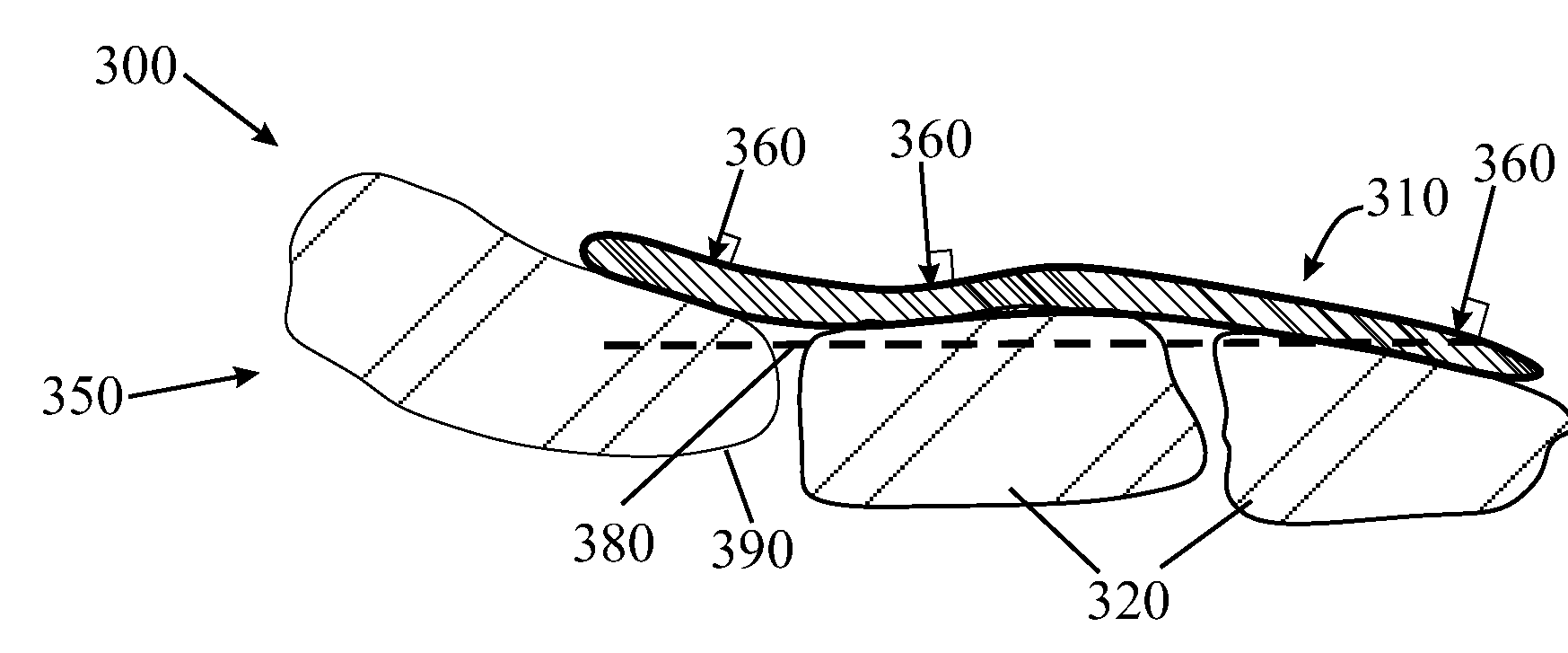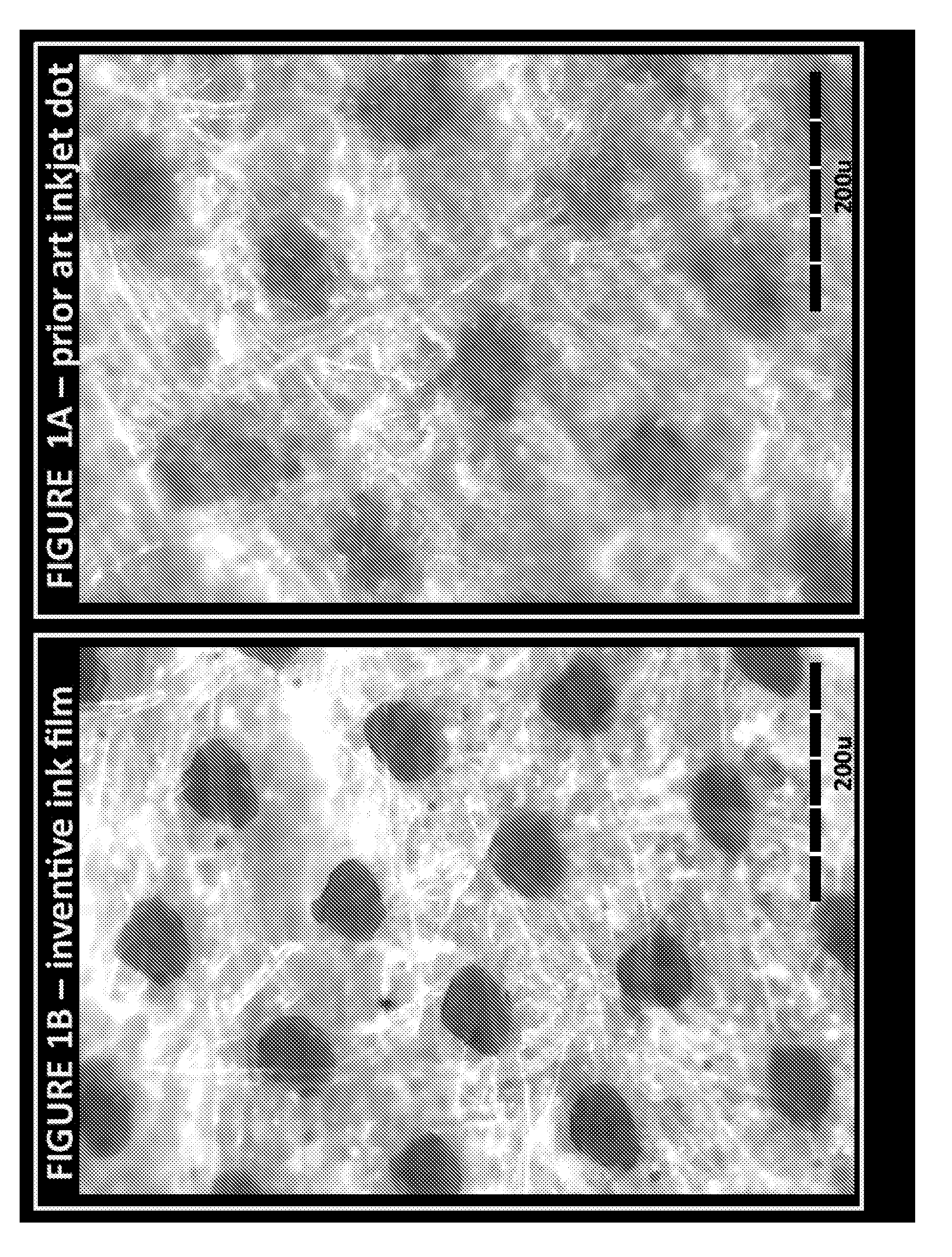Ink film constructions
a technology of ink film and construction, applied in the direction of electrographic process, dyeing process, instruments, etc., can solve the problems of poor image quality, unsuitable for certain printing applications, and inability to produce images of a quality acceptable for publications such as magazines,
- Summary
- Abstract
- Description
- Claims
- Application Information
AI Technical Summary
Benefits of technology
Problems solved by technology
Method used
Image
Examples
example 2
[0150]An inkjet ink formulation was prepared containing:
[0151]
IngredientFunctionwt. %PV Fast Blue BG (Clariant)Pigment2.3Neocryl BT-9 (40% waterResin16.5dispersion) (DSM resins)Glycerol (Aldrich)Water-miscible3.3co-solventCapstone FS-65 (DuPont)Non-ionic0.1fluorosurfactantWater (distilled)—Balance to 100%Joncryl HPD 296 (35.5%Dispersant3.2 (solid resin)water solution) (BASF)Diethyleneglycol (Aldrich)Water-miscible20co-solventDiethyl amine (Aldrich)pH adjustment1(basic)
Preparation procedure:
[0152]A pigment concentrate, containing pigment (14%), water (79%) and Joncryl HPD 296 (7%) were mixed and milled. The progress of milling was controlled on the basis of particle size measurements (Malvern, Nanosizer). The milling was stopped when the average particle size (d50) reached 70 nm. The remaining materials were then added to the pigment concentrate and mixed. After mixing, the ink was filtered through a 0.5 μm filter.
[0153]At 25° C., the viscosity of the ink thus obtained was about 13 c...
example 3
[0154]An inkjet ink formulation was prepared containing:
[0155]
IngredientFunctionwt. %Jet Magenta DMQ (BASF)Pigment2.3Neocryl BT-26 (40% waterResin17.5dispersion) (DSM resins)Monoethanol aminepH adjustment1.5(basic)Propylene glycolWater-miscible20co-solventN-methylpyrrolidoneWater-miscible10co-solventBYK 349 (BYK)surfactant0.5(silicone)Water (distilled)—Balance to 100%
Preparation procedure:
[0156]The pigment (10%), water (69%), Neocryl BT-26 (20%) and monoethanol amine (1%) were mixed and milled until the average particle size (d50) reached 70 nm as described in Example 2. The rest of the materials were then added to the pigment concentrate and mixed. After mixing, the ink was filtered through a 0.5 μm filter.
[0157]At 25° C., the viscosity of the ink thus obtained was about 8 cP, the surface tension was approximately 24 mN / m, and the pH was 9-10.
example 4
[0158]An inkjet ink formulation was prepared containing:
[0159]
IngredientFunctionwt. %Jet Magenta DMQ (BASF)Pigment2.2Joncryl 683 neutralizedDispersant0.6 (solid resin)with KOH (BASF)Neocryl BT-9 (40% waterResin25dispersion) (DSM resins)Ethylene glycolWater-miscible25co-solventPropylene glycolWater-miscible10co-solventPEG 400Water-miscible2co-solventGlycerolWater-miscible3co-solventBYK 349 (BYK)surfactant0.5(silicone)Water (distilled)—Balance to 100%
Preparation procedure:
[0160]The pigment (12.3%), Joncryl 683 (3.3%) fully neutralized with a 30% solution of KOH (7.9%) and water (balance) were mixed and milled until the average particle size (d50) reached 70 nm as described in Example 2. The rest of the materials were then added to the pigment concentrate and mixed. After mixing, the ink was filtered through a 0.5 μm filter.
[0161]At 25° C., the viscosity of the ink thus obtained was about 7 cP, the surface tension was approximately 24 mN / m, and the pH was 7-8.
PUM
 Login to View More
Login to View More Abstract
Description
Claims
Application Information
 Login to View More
Login to View More - R&D
- Intellectual Property
- Life Sciences
- Materials
- Tech Scout
- Unparalleled Data Quality
- Higher Quality Content
- 60% Fewer Hallucinations
Browse by: Latest US Patents, China's latest patents, Technical Efficacy Thesaurus, Application Domain, Technology Topic, Popular Technical Reports.
© 2025 PatSnap. All rights reserved.Legal|Privacy policy|Modern Slavery Act Transparency Statement|Sitemap|About US| Contact US: help@patsnap.com



